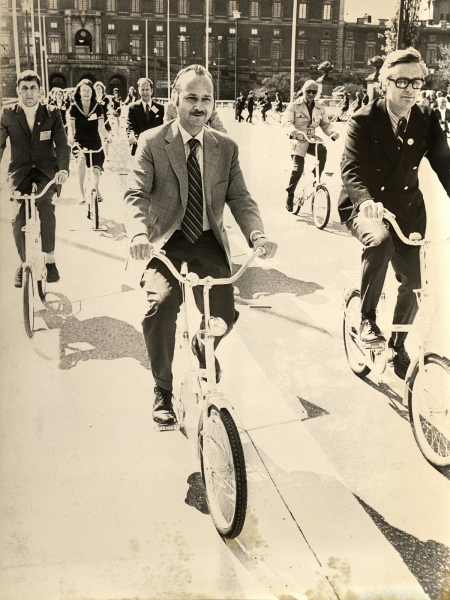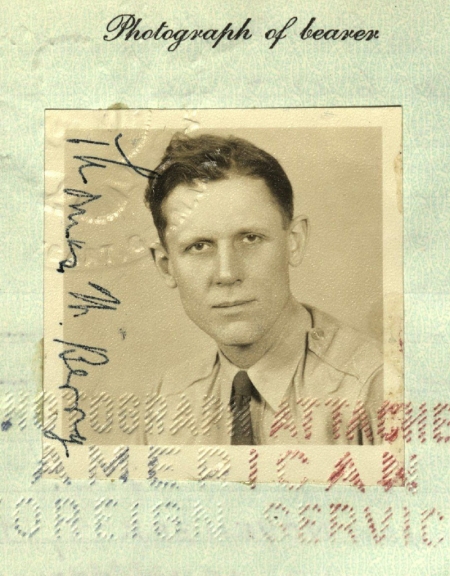
The Environmental Science and Public Policy Archives (ESPPA) has materials in the fields of environment and sustainability science, related public policy, and cultural perspectives on the environment.
There is a strong but not exclusive emphasis on international environmental governance, including climate negotiations.
The ESPPA is a global center for researchers interested in the history of climate change policy, toxicity and native peoples, and the standout success story of stratospheric ozone diplomacy.
The ESPPA is proud to host the papers of the U.S.-hosted working groups of the Intergovernmental Panel on Climate Change.
Other collections include:
Maurice Strong Papers
The Maurice Strong papers were created during Strong’s 30-year career in the development of the international environmental policy field.

Strong, a senior advisor to the secretary-general of the United Nations and former senior advisor to the president of the World Bank, was one of the world’s most influential environmental players. Strong served on the board of directors for the United Nations Foundation and as a director of the World Economic Forum Foundation, chairman of the Earth Council, chairman of the Stockholm Environment Institute, and chairman of the World Resources Institute.
In his native Canada, Strong amassed a fortune in energy and natural resources while working at the Power Corporation of Canada, Ontario Hydro, and Petro-Canada (the national oil company).
Strong first worked with the United Nations as a junior officer in 1947 when he was just 18, and returned in 1970 to lead the Conference on the Human Environment in Geneva, after which he became the first head of the United Nations Environment Programme.
Strong also coordinated the UN’s emergency relief efforts in Africa in the mid-1980s and was in charge of the historic 1992 Earth Summit in Rio.
Peter Thacher Papers (Part 1 and Part 2)
Peter Thacher was a veteran foreign service officer who went on to become deputy executive director of the United Nations Environment Programme. He later advised the World Health Organization, the International Council of Scientific Unions, and the International Union for the Conservation of Nature and Natural Resources. (He was the deputy at UNEP to Maurice Strong, whose papers are also held in the ESPPA.)
Marion and Barney Lamm Collection
The Lamm collection includes materials related to environmental contamination in Canada that came to light in the late 1960s and early 1970s. It might be called Canada’s version of Love Canal, except that contamination still lingers and falls disproportionately on First Nations peoples.
Minamata Disease (acute mercury poisoning) occurred among the Grassy Narrows First Nation downstream from the Dryden Pulp and Paper Company in northern Ontario. The gatherers of the collection, Marion Lamm and her husband Barney, were owners of a fly-in fishing lodge that was ultimately closed due to the mercury contamination. They employed First Nation guides at the lodge.
Despite the damage to the Lamm’s economic circumstances and to their relationships with fellow fishing camp owners who were reluctant to make the problem public, the Lamms brought the public health problem to light.

Thomas Berry Papers
Personal papers documenting the life, thought, and writings of cultural historian Thomas Berry, 1914–2009.
Berry’s work posits that the world’s religions have until recently neglected the growing environmental crisis. Berry lays out transformative approaches involving the need to connect science, humanism, religion, and multiple voices in order find a way forward.
His commitment to the traditions of Asia, especially Confucianism, not only informed his work, but also opened the door to improved engagement of Christianity with Asian religions, as well as other world faiths.
In addition, his call for a “New Story” for a flourishing future inspired much of his later writing, including The Universe Story. See also the Thomas Berry interview, which includes edited and raw footage of Martin Ostrow's June 17, 2000 interview of Berry.
Sarma-Andersen Montreal Protocol Collection
Materials from 1963 to 2010 on stratospheric ozone policy and diplomacy from K. Madhva Sarma (India, secretary of the Ozone Secretariat) and Stephen O. Andersen (U.S., Environmental Protection Agency).
The materials in this collection were used in the writing of their book Protecting the Ozone Layer, The United Nations History.
It includes materials issued by governments, the military, environmental NGOs, and industry organizations. Along with the Parson ozone collection, these materials establish the Environmental Science and Public Policy Archives as the preeminent repository for this major success story of international environmental governance.
Edward A. Parson Stratospheric Ozone Collection
Materials on the science and negotiations around protecting the stratospheric ozone layer. Includes diplomatic cables, delegation reports, internal memos, and other correspondence.
Edward A. Parson Climate Change Collection
Materials dated 1988 to 1995 on global climate change, including the Earth Summit, the 1992 United Nations Conference on Environment and Development. Includes significant holdings of official, independent, and metropolitan newspapers during the conference.
Johannesburg 2002 World Summit for Sustainable Development
This landmark meeting ushered in the formal participation of global civil society in setting goals making transnational commitments for international sustainability. The African venue echoed the founding of the United Nations Environment Programme on that continent 30 years earlier.
The collection includes ephemera, both tangible and born-digital, from the 2002 meeting.
Biodiversity Support Program
Materials from a consortium of the World Wildlife Fund, The Nature Conservancy, and the World Resources Institute, 1989–2001, a program funded by the U.S. Agency for International Development.
Nuclear Winter Study Papers
Contributed by Michael MacCracken, a scientist at Lawrence Livermore Laboratory from 1968 to 1993 who later served as the first director of the United States Global Change Research Program. MacCracken is a pioneer in global climate modeling.
Accessing These Materials
Materials in this collection are cataloged in HOLLIS. Access to the materials is by appointment only. Appointments must be confirmed at least one week prior to your visit. Contact the curator to book an appointment.